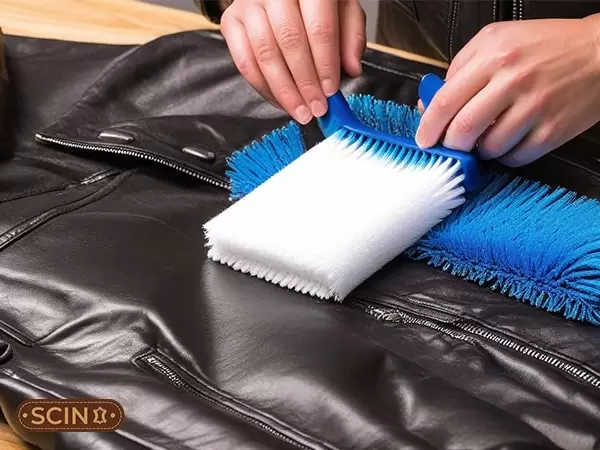The supple touch and timeless appeal of a leather jacket are what make it a staple in anyone’s wardrobe. Although, what do you do when your once-flawless leather jacket surface starts feeling sticky? Fret not, we are here to help! We will guide you through the step-by-step process of reviving your leather jacket back to its former glory while getting rid of the sticky leather surface.
So, let’s dive into the reasons behind your sticky leather jacket. Also, explore the right materials required for cleaning the leather surface as well as how to ensure your leather jacket keeps looking as good as new for years.
Understanding Sticky Leather
Never heard of leather becoming sticky? Well, it is a very common worry. A sticky leather jacket feels tacky and adhesive to the touch. This stickiness could result from various factors such as exposure to moisture, residue from the cleaning products, or the breakdown of certain finishes or treatments on the leather.

Over the span of years, dirt, body oils, debris, and various other environmental factors can build up on the surface of your leather jacket as well. Thus, resulting in the unpleasant stickiness of the leather. Well, the good news is that with proper care, you can get rid of the stickiness while easily restoring your leather jacket’s smooth texture.

Materials Needed
- Soft cloth or sponge – For gentle cleaning.
- Mild soap or leather cleaner – To effectively remove stickiness.
- Distilled water – To create a safe cleaning solution.
- White vinegar – An alternative for a natural cleaning solution.
- Leather conditioner – Essential for restoring moisture.
- Soft brush or toothbrush – For targeted cleaning.
- Clean, dry towel – To wipe away residue.
Step-by-Step Guide: Fixing a Sticky Leather Jacket
Step 1: Assess the Damage
Begin by closely inspecting your leather jacket surface. The sticky leather is very obvious to the touch and easily identifiable. If your leather jacket starts feeling sticky, examine the surface for any visible stains, dirt, or debris. Doing so helps you target your cleaning efforts effectively.
Step 2: Dust off Loose Dirt
Firstly, use a brush with soft bristles or a clean, dry cloth to gently remove any loose dirt stuck to the leather jacket’s surface. Make sure not to scratch the leather by any means.


Step 3: Create a Cleaning Solution
Make the cleaning solution by mixing a small amount of mild soap or leather cleaner with water. Closely follow the product instructions to get the perfect ratio of water to cleaner. Moreover, you can also create a natural cleaning solution at home by mixing equal parts white vinegar and water.
Step 4: Test in an Inconspicuous Area
Now, before the full application of the cleaning solution to the entire leather jacket, we test it on a small, hidden area to observe any reactions. This is to ensure the cleaning solution won’t cause any damage or discoloration to the leather.
Step 5: Clean the Sticky Areas
After observing no reactions, dip a soft, clean cloth in the cleaning solution and gently scrub the sticky areas of your leather jacket. You may use it to clean the entire surface of the leather jacket as well as to get rid of the leather growing sticky day by day. Also, scrub in circular motions to get rid of the stickiness while paying extra attention to stains or heavily soiled spots.

Step 6: Rinse and Dry
After cleaning, wipe the leather with a clean, damp cloth to remove cleaning solution residue. Next, wipe the leather jacket fully using a separate clean, dry towel and hang it to air dry. Remember not to dry your leather jacket in the sun or use any heat sources as the leather can lose its natural oils.

Step 7: Condition the Leather
Conditioning prevents your leather jacket from getting sticky in the future. So, when your leather jacket is fully dry, apply a small amount of leather conditioner to maintain the supple, soft texture of your leather jacket while also restoring its natural oils. Make sure you follow the product instructions to get the best results.
Preventive Measures for Sticky Leather
Apart from the cleaning process, it is crucial to adopt preventive measures to ensure your leather jacket stays in top-notch condition. Here are a few tips:
- Regular Inspection: Make sure you regularly check for any signs of stickiness or stains on the leather jacket.
- Storage: Store your leather jacket in a cool, dry place away from direct sunlight to prevent any damage to the leather surface.
- Avoid Harsh Chemicals: Be mindful about the cleaning products you use by opting for mild soaps or specially designed leather cleaners for your leather type.
- Moisture Control: Keep your leather jacket away from excessive moisture, as it can lead to mold and mildew growth.
- Proper Ventilation: Allow your leather jacket to breathe and avoid storing it in plastic bags as they can trap moisture causing mold and mildew to grow.
